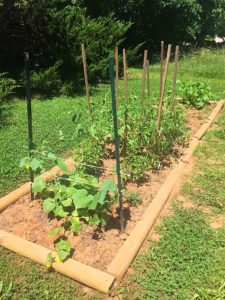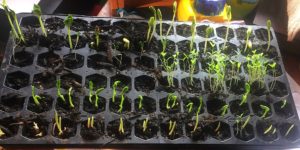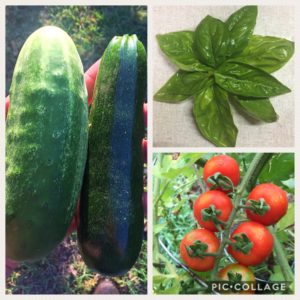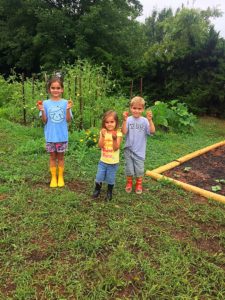 I am not an expert gardener. But I do have what I consider a pretty big motivation: my family. With five kids at home, and only one of us working full time, our budget is extremely tight. Yet I still I want to be able to provide healthy food for our children. I not only want them to learn to enjoy eating healthy, but to experience the satisfaction of working together for each other’s good. After our rental house chose not to renew our lease, we met with a real estate agent at our church and discovered to our surprise that that we would be able to buy our own house. You can read more about that here. We moved into our home last November. As Cherie and I walked around the half acre of open field beside our house, we immediately began planning what we could do with all that God had given us. We wanted chickens, rabbits, bees, goats, gardens, orchards, a fire pit, a sandbox and a playground for the kids, and… OK we might not be able to fit all that in there: but we will do our best. This is what we were able to do on the gardening front our first summer.
I am not an expert gardener. But I do have what I consider a pretty big motivation: my family. With five kids at home, and only one of us working full time, our budget is extremely tight. Yet I still I want to be able to provide healthy food for our children. I not only want them to learn to enjoy eating healthy, but to experience the satisfaction of working together for each other’s good. After our rental house chose not to renew our lease, we met with a real estate agent at our church and discovered to our surprise that that we would be able to buy our own house. You can read more about that here. We moved into our home last November. As Cherie and I walked around the half acre of open field beside our house, we immediately began planning what we could do with all that God had given us. We wanted chickens, rabbits, bees, goats, gardens, orchards, a fire pit, a sandbox and a playground for the kids, and… OK we might not be able to fit all that in there: but we will do our best. This is what we were able to do on the gardening front our first summer.
At Christmas Cherie got me a book about being self sufficient on half an acre. It warned against buying plants as being financially impractical. That was encouraging. Buying plants at some home improvement store, which is what I always imagined, was not an option for us. Our budget was way too restricted. We did have enough to buy seeds. With that as a guide we started to plan. On March 4th we started planting seeds indoors in a small tray. We planted corn, tomatoes, yellow and green squash, and snow peas. By the 17th we had moved the squash into larger containers and by the 28th we had moved the sugar snap peas outdoors. After that we planted more peas, mint, and some watermelon. Unfortunately after that burst of success nothing else seemed to go right. The peas did not acclimate well and produced only a few pea pods before dying. The squash met with one disaster after another and by the end of it none survived. The cat ate, or chewed up, several. The dog knocked them over trying to get the cat, and while moving them outside for portions of the day to acclimate them, birds and slugs did in the rest. Apparently corn does not do well as a transplant crop ether.
 Either that or I did it wrong. The mint never sprouted, and most of the watermelon did not make it. I took the last of my tomatoes that had stopped growing after about three inches to our church to ask Lena about them. Lena has a degree in agricultural theology. What is agricultural theology? I don’t know, but it sounds impressive. On top of that she runs the farm our church is starting and knows a lot more than I do. So there I was standing in our fellowship hall/greenhouse with my few sick tomatoes waiting for Lena to tell me what I was doing wrong. She glanced at them and said “They aren’t getting enough sun.” Right. I had moved them from my desk to the wood stove to avoid the cat who sits there watching the birds at the feeder. There was another window that had been giving enough light, but as the leaves filled in on our trees that had changed without my noticing.
Either that or I did it wrong. The mint never sprouted, and most of the watermelon did not make it. I took the last of my tomatoes that had stopped growing after about three inches to our church to ask Lena about them. Lena has a degree in agricultural theology. What is agricultural theology? I don’t know, but it sounds impressive. On top of that she runs the farm our church is starting and knows a lot more than I do. So there I was standing in our fellowship hall/greenhouse with my few sick tomatoes waiting for Lena to tell me what I was doing wrong. She glanced at them and said “They aren’t getting enough sun.” Right. I had moved them from my desk to the wood stove to avoid the cat who sits there watching the birds at the feeder. There was another window that had been giving enough light, but as the leaves filled in on our trees that had changed without my noticing.
With a constant stream of questions I learned how to properly acclimate the remaining seedlings and avoid another dozen pitfalls. By the end of April we had manually double dug two beds and moved the few survivors into the earth. This was made so much easier after I bought a spading fork! Several people at my church and a few friends at work donated tomato plants to us that they did not need because their seedlings had done so well. All of them had just used disposable cups with a hole punched in the bottom. With much better information, and no chance of a dog knocking the beds over, we had a lot more success. I did eventually rip out most of the tomatoes I had grown from seed due to lack of growth, but one of them did survive to become the largest plant in the garden. It’s a win in my book.
We had a lot of good rain at the first of the season. Then the blistering mid summer of North Carolina set in and the rain stopped. We did get an occasional drizzle, but not many good soaking rains. We did a good job of watering through the hottest time of the year, and then ended up watering too much. This was a hard lesson. During this time I was also learning about how to correctly prune tomatoes. One rule I was told is to prune off lower leaves to prevent blight, a fungal disease that lives in the soil, and any leaves that have blight to prevent it from spreading. The problem was that blight, to my untrained eye, looks similar to the yellowing of leaves due to over-watering. This in turn encourages blight, because the leaves are not healthy. So there I was, drowning the roots and cutting off the leaves and wondering why my plants were getting sicker. Fortunately research saved me again and my crop was not reduced to dry leafless stalks tied to sticks. Although now that I think of it, it would have made a funny picture.
Our garden was relatively pest free, but we did have a few greenhorn caterpillars, squash root borers, flea beetles, and other, as of yet, unidentified pests. Instagram was a life saver once or twice when Google failed me. Having a community of people to send a picture of a pest to and ask for help saved us more than once. I will cover that more in a future post.

First Fruits
The season was not a full disaster. We actually had more success than we had in the past trying to garden in pots while renting. We have eaten healthier this past summer than we have in a while. For example: our kids were fed vegetables on a regular basis. There was never one refusal, which I credit in part to the tomatoes and cucumbers being from our garden. They often asked what came from the garden, or if we grew whatever they were holding up to us. My wife was able to can zucchini relish and we had enough basil and Thai basil to give away to friends. The two beds we put in are not done producing, so we started a third bed to have a fall crop which we have never tried to do before. We planted winter squash, pumpkins, carrots, and we are making another attempt at peas. While that bed is just sprouting, we are confident that the lessons we learned over the summer will make the fall crop even more successful.
Here are three things I would have done differently:
Planning layout: I would have planned out where I planted what better. We received so many gifted tomato plants that this was a little difficult to do. However I filled up one bed with what I had before moving to the next. The end result was that there were tomato plants in both beds which will make it a little more difficult to do any crop rotation with them next spring. We also did a row of kale and lettuce which ended up getting shaded out by the tomatoes. While I think the kale would have died without the shade, I could have done other things like plant them more densely to provide them some protection, and the lettuce didn’t survive at all. I should have thought through that a little bit more and not planted those in the middle of the bed.
Journaling: Maybe calendaring would be a better way of putting it. I would have scheduled my fertilizing and watering, and kept better records of when I did it, and what I added. At one point I was trying to figure out what was wrong with our cucumbers. They were drying up and starting to be attacked by flea beetles. The insects were at least in part a symptom of the the plant already being stressed. Was I over-watering? Under-watering? Did it need nitrogen, and so another application of fertilizer? Or had I added too much fertilizer, and I needed to hold off? Trial and error did end up solving the problem, but if I had been keeping track of things I would have been able to pinpoint the issue much faster, or at least rule out one or two issues. This turned out to be connected with over-watering, but it took longer than it should have because I had not been keeping track of details. And those bugs that showed up? I have no dates for them. So instead of applying the pesticides after the fact, I could have added it a week early next year, and prevented (or at least reduced) the problems all together. Needless to say, this Journal is on our wish list for Christmas!
Meal planning: Much of our garden this year was based on things our parents had grown, things our kids asked for when seed shopping, or things that I found and thought would be good at the last second. While we still would have planted many of the same things like tomatoes and cucumbers, we also have a lot of hot red peppers growing and a lot of extra Thai basil. We only use those for a few dishes, and so while we have been able to give some away, we could have added a few other herbs like thyme and oregano which we did not make room for. I also would have grown a lot more cucumbers and zucchini.  We had a few plants of each, which was enough to eat during the summer but not enough to preserve any through the winter (with the exception of Cherie’s zucchini relish). Next year we will look more at what our diet is, what we want it to be, and a little less spur of the moment improvisation.
We had a few plants of each, which was enough to eat during the summer but not enough to preserve any through the winter (with the exception of Cherie’s zucchini relish). Next year we will look more at what our diet is, what we want it to be, and a little less spur of the moment improvisation.
All in all, it was a season of very mixed results. We learned a lot, and got a better sense of how much there is to know. Yet it was only the start of our journey. A journey that will hopefully help us to grow together as a family while teaching our kids valuable lessons in living healthy independent lives. I am excited about the the fall season, and even about next spring. I have already requested seed catalogs and a chicken catalog. I don’t know if we will be ready for any animals by then, but it’s nice to dream. And it’s nice to work at turning your dreams into reality.


One thought on “A Rough Beginning: How Our Garden Began”
Comments are closed.